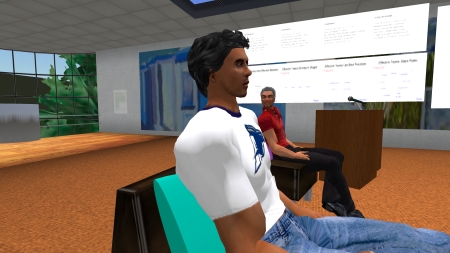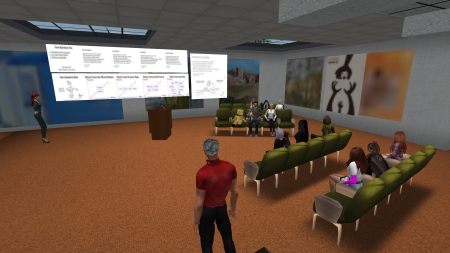This week we were joined by Dudley Dreamscape who led the class discussion about the influence of Marshall McLuhan on our thinking about digital media, online and virtual environments in the 21st Century. Introducing Dudley, John noted that along with Sitearm Madonna, he had a perfect score when he participated in the module some years ago. Not surprising, perhaps, for a communications professor at the University of Akron! Also joining the class was a fellow graduate of Dudley’s, Inish Karu who had a reputation as a fearsome SL pirate but, judging from her current avatar, has since mellowed somewhat.
After introducing McLuhan’s basic ideas to the class Dudley asked you to consider how they might be interpreted today. His remarkable prescience was noted – he foresaw the internet 35 years before it was developed – describing the transformation of our disconnected 20th Century world in a Global Village facilitated through an electronic nervous system. Of course all tools developed by humans can be used for good or ill. You gave many examples of the downside of our always-on society and the attention-grabbing power of connected devices. This can lead to the echo chamber effect whereby our sphere of understanding and experience shrinks as the dissenting voices are silenced or eliminated.
Dudley explained McLuhan’s belief that while humans develop tools to help us with our tasks the same tools change us and our society. It is difficult to predict the type of change that will come about therefore vigilance is crucial. That is why it is so important not to overlook the medium while digesting the message. The medium (ie, the tool) has a longer lasting and deeper effect on our lives than the message it carries. Although McLuhan’s thinking can be difficult to grasp at times the basic concepts are quite clear and seemed to resonate with the class. This was due, in no small part, to Dudley’s generosity as he led us through the complexity, distilling the essence and encouraging a deeper engagement with the propositions. Please continue this as you begin work on your projects.






